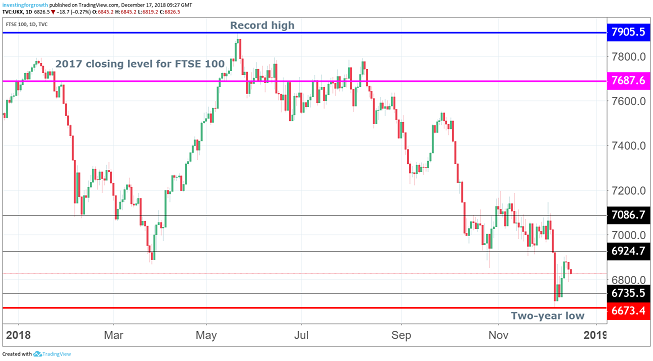Will 2019 take the BISCUIT?
17th December 2018 09:52
by Richard Hunter from interactive investor
As 2018 nears an end and investors make wishes for a Santa rally, interactive investor's head of markets Richard Hunter provides some thoughts on the year ahead.

B rexitI nterest ratesS terlingC hinaU SI nflationT rump
In the words of one institutional international investor, the UK equity market is currently close to being "uninvestable", as Brexit concerns – let alone the possibility of a Labour win if a general election was called – weigh heavily on investors.
In a survey earlier in the year, the FTSE 100 ranked last amongst investors (and even below cash as an asset class) as a preferred investment destination. As such, not having partaken in the global market rally earlier in the year, the FTSE 100 stands down over 11% in the year to date.
The relentless surge of pessimism could persist during 2019 as the full ramifications of Brexit become a little clearer. In the meantime, the average dividend yield of the FTSE 100 is at present 4.4%, a clear invitation to income seeking investors who are being paid to wait for any recovery.
This aside, for those investors looking to take a "bottom up", or stock specific approach, there are any number of world-class quality companies within the index, some of whom are largely immune from Brexit uncertainties and/or are defensive by nature. For example, the Consumer Staples sector, which accounts for some 16% of the FTSE 100 by value, contains the likes of British American Tobacco, Diageo, Unilever and the supermarkets.
A small change in sentiment towards the UK market could begin a domino effect, such that the FTSE 100 could well transform from an investment frog to a prince in 2019, given even the smallest of nudges.

Source: TradingView (*) Past performance is not a guide to future performance
The direction of interest rates will continue to be of importance particularly in the US, where investors had previously been pricing in four hikes during 2019, per Fed guidance, whereas the current estimate is for just one, in the face of potentially slowing growth and a softer housing market.
Sterling has certainly been in the firing line and has rarely been so closely watched as the Brexit saga has unfolded. In the meantime, any weakness in sterling should be positive for the FTSE 100 where an estimated 70% of earnings from FTSE 100 companies are derived from overseas, such that in the face of any sterling weakness, overseas earnings become more valuable.
However, this relationship has not necessarily followed the expected route at times in 2018, depending on overall sentiment. Indeed, in the year to date the pound is down 6.7% against the US dollar, for example and yet the FTSE 100 has also fallen.
Of particular concern to investors during 2018 has been the escalation of the trade tensions between China and the US. Despite the apparent détente at the recent G20 meeting, tariffs are beginning to bite and any resumption of talks aiming at implementing further duties in the New Year would pile further pressure on both Chinese and American markets, as has been the case in recent months.
Inflation also has been caught between rising real wages – usually an invitation for Central Banks to be raising rates – and the oil price, which has been under pressure due to the twin concerns of slowing global growth (signifying lessening demand) and oversupply.
Then there are the tweets of the self-proclaimed "Tariff Man" in the form of President Trump. Some have become desensitised to his daily and abundant tweets, but there is little doubt that some of his 280-word diatribes have the force to be market-moving.
January 2019 will herald the onset of the full-year reporting season, with corporate earnings hoping to continue the momentum of the previous quarters. Of equal interest will be any outlook comments or guidance, which could well set the scene for what could be a challenging year.
For those investors wishing to buy more cautiously, the traditional "bottom up" approach would not only provide some defensive shelter but also give some exposure to a sustained uptick.
An index which could therefore be one to watch, either stock specifically or indeed as a whole, could yet be the currently beleaguered FTSE 100.
*Horizontal lines on charts represent levels of previous technical support and resistance. Trendlines are marked in red.
These articles are provided for information purposes only. Occasionally, an opinion about whether to buy or sell a specific investment may be provided by third parties. The content is not intended to be a personal recommendation to buy or sell any financial instrument or product, or to adopt any investment strategy as it is not provided based on an assessment of your investing knowledge and experience, your financial situation or your investment objectives. The value of your investments, and the income derived from them, may go down as well as up. You may not get back all the money that you invest. The investments referred to in this article may not be suitable for all investors, and if in doubt, an investor should seek advice from a qualified investment adviser.
Full performance can be found on the company or index summary page on the interactive investor website. Simply click on the company's or index name highlighted in the article.